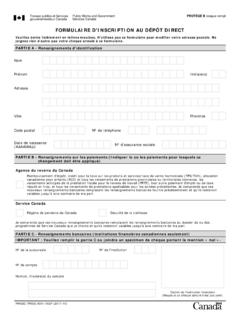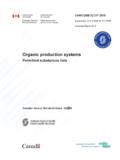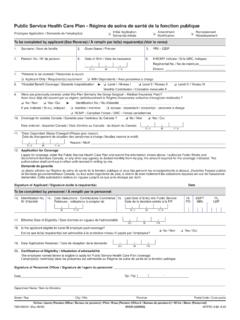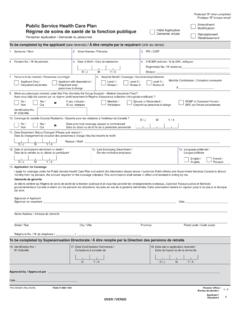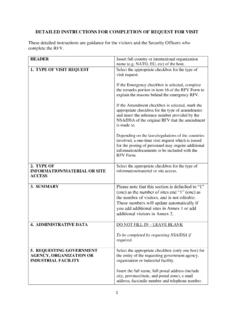Transcription of Office of Energy Efficiency Natural Resources …
1 For additional copies of this or other free publications on Energy Efficiency , contact: Energy PublicationsOffice of Energy EfficiencyNatural Resources Canadac/o St. Joseph CommunicationsOrder Processing Unit1165 Kenaston StreetPO Box 9809 Stn TOttawa ON K1G 6S1 Tel.: 1-800-387-2000 (toll-free)Fax: 613-740-3114 TTY: 613-996-4397 (teletype for the hearing-impaired)Cat. No. M144-234/2011E (Print)ISBN 978-1-100-19261-1 Cat. No. M144-234/2011E-PDF (On-line)ISBN 978-1-100-19262-8 Aussi disponible en fran ais sous le titre : Ventilateurs-r cup rateurs de chaleurRevised February 2012 Her Majesty the Queen in Right of Canada, 2012 You can also view or order most Office of Energy Efficiency spublications on-line. Visit our Virtual Library at The Office of Energy Efficiency s Web site is For information regarding reproduction rights, contact Public Works and Government Services Canada (PWGSC) at 613-996-6886 or at paper1 Heat Recovery VentilatorsProduced byNatural Resources Canada s Office of Energy EfficiencyEnerGuideThe Heating and Cooling Series is published by Natural Resources Canada s Office of Energy Efficiency .
2 EnerGuide is the official Government of Canada mark associated with the labelling and rating of the Energy consumption or Energy Efficiency of household appliances, heating and ventilation equipment, air conditioners, houses and vehicles. EnerGuide also helps manufacturers and dealers promote Energy -efficient equipment and provides consumers with the information they need to choose Energy -efficient residential STAR Natural Resources Canada s Office of Energy Efficiency promotes the international Energy STAR symbol in Canada and monitors its use. Major manufacturers and retailers of Energy -efficient products, utilities and Energy retailers, and interest groups from Australia to Europe, recognize the benefits of Energy STAR for consumers and have joined in promoting the symbol. Energy STAR is the international symbol of premium Energy Efficiency . Products that display the Energy STAR symbol have been tested according to prescribed procedures and have been found to meet or exceed high Energy Efficiency levels without compromising Introduction.
3 42. The need for mechanical ventilation ..5 Circulating fresh air in new Circulating fresh air in conventional homes ..5 Household How much ventilation does your home need? ..73. The HRV system ..8 Components of an HRV Air High- Efficiency Checking airflow room by The need for a balanced system ..14 Do-it-yourself balance Operating your HRV ..17 Low-speed operation ..18 High-speed Heating season operation ..19 Non-heating season operation ..20 All-season Energy STAR for Routine Seven-step maintenance schedule ..226. HRV maintenance HRV troubleshooting Need more information? ..3141 IntroductionThe importance of ventilation in today s more Energy -efficient homes is universally recognized. Introduced as a requirement for airtight R-2000* homes, continuous ventilation systems are now common in new housing and major home renovations. Because of the Energy savings generated, the system of choice is often a heat recovery ventilator (HRV) or Energy recovery ventilator (ERV).
4 During the remainder of this publication, we will refer only to HRV; however, please note that this applies to both HRVs and HRV is a mechanical ventilation device that helps make your home healthier, cleaner and more comfortable. It does so by continuously replacing stale indoor air with fresh outdoor air. HRVs are set apart from other mechanical ventilation devices. Their ability to exchange heat between the supply and exhaust air streams reduces the cost of heating or cooling the healthy fresh air circulating through the home. HRVs are sometimes called air-to-air heat exchangers because they preheat or cool incoming air using exhaust booklet discusses the need for mechanical ventilation in homes. It also explains the components of an HRV system, how to operate and maintain the system, and how to solve operating problems. You will find this information useful, whether you occupy a home with an HRV or plan to have one installed. There are many types of HRVs on the market, as well as different installation strategies.
5 The size of your house, type of heating system and geographical location, for example, can affect the kind of system you have and the way it has been installed. The diagrams in this booklet give examples of the types of systems available; they are provided for information booklet is intended to supplement your HRV owner s manual, not replace it. If you need a manual or more information on operating procedures for your HRV, contact the installer or manufacturer. * R-2000 is an official mark of Natural Resources The need for mechanical ventilationCirculating fresh air in new homesNew homes are built to be airtight. This limits the uncontrolled flow of air in and out of the home and reduces heat loss and moisture damage to the building complement this airtightness and ensure a healthy living environment, modern homes use a mechanical ventilation system to remove pollutants from the home by replacing stale indoor air with fresh outdoor air. These pollutants come from a range of sources from household contents and materials to people and their activities and pets (see Household pollutants on page 6).
6 In most homes, the mechanical ventilation system is an HRV. This system allows fresh air to be distributed throughout the house. A properly installed, operated and maintained HRV exhausts indoor air pollutants and excess humidity to the outdoors while distributing fresh air throughout the house. During the heating season, the HRV captures heat from the outgoing air and uses it to preheat the incoming fresh air. During the cooling season, an HRV can reverse this heat-exchange process, removing some of the heat from the incoming air and transferring it to the outgoing fresh air in conventional homesIn recent years, more and more homes have undergone Energy Efficiency improvements such as upgraded insulation, improved air sealing and the installation of Energy -efficient windows, doors and heating systems. In many of these homes, air infiltration through doors, windows and other openings in the building shell is random and does not always provide adequate ventilation, which is just as important in a conventional home as in a new home.
7 Even with an acceptable rate of air exchange, the fresh air may not reach the rooms where it is needed. As a result, mechanical ventilation is needed in many conventional homes to distribute fresh air evenly throughout the 6*CAUTION: Do not rely on an HRV to remove combustion by-products from your home or to supply the combustion air requirements of fuel-burning appliances. Combustion appliances should have their own air supply for combustion. If combustion by-products are escaping into your home, an appliance or its venting system is not operating properly and must be repaired immediately. Fuel-burning appliances should be installed to vent to the outdoors. Unvented fuel-burning appliances such as barbecues, portable gas-fired or kerosene space heaters or unvented gas fireplaces are not recommended for use indoors. Natural draft appliances and water heaters should be and maintain a healthy living environment. An added benefit of mechanical ventilation systems is their capability to filter the incoming fresh outdoor pollutantsYou can eliminate or reduce certain sources of indoor air pollution by understanding where household pollutants come from.
8 However, no matter how careful you are, there will always be some pollutants in your home and, therefore, a need for 1 identifies the most common pollutants and their sources. Additional information on indoor air quality is available from the Canada Mortgage and Housing Corporation s Canadian Housing Information Centre, at the address provided on page 1 Common pollutants and their sourcesPollutantSourceExcess moisture and mouldsA crawl space with an exposed earthen floor, people, clothes drying indoors, cooking and washing, plants, firewood stored indoors, formaldehydeSome types of particle board, panelling, carpeting, furniture, textiles, and groundwaterTobacco smokeSmokingHousehold chemicalsCleaning products, certain hobby supplies, paints and solvents, aerosols, , viruses, bacteria and dandruffPeople and petsCombustion by-products (including carbon monoxide, nitrogen oxides, carbon dioxide and particulates)Fuel-burning appliances, including furnaces, heaters, ranges/ovens, gas clothes-dryers, fireplaces, wood stoves, etc.
9 *7 How much ventilation does your home need?The capacity of a home s ventilation system is usually based on the number of rooms in the house. HRV capacity is measured in litres per second (L/s), or cubic feet per minute (cfm), of fresh air provided to the the information in Table 2, you can calculate how much fresh air your home needs under normal circumstances to maintain good air 2 Fresh air requirements per roomRoomVentilation air supplyMaster bedroom10 L/s (20 cfm)Unfinished basement10 L/s (20 cfm)Other rooms 5 L/s (10 cfm) eachBased on these figures, a ten-room home (unfinished basement, living room, dining room, family room, kitchen, two bathrooms, master bedroom and two bedrooms) requires an HRV with a rated capacity of 60 L/s (120 cfm).To ensure adequate ventilation, the HRV s ventilation capacity at high speed should be close to this total (see High-speed operation, page 18). The suggested low-speed HRV ventilation rate should be from 40 percent to 60 percent of the high-speed rate.
10 HRVs with high- Efficiency motors (see High- Efficiency motors, page 12) can operate at lower speeds, based on The HRV systemComponents of an HRV systemAn HRV system consists of the following equipment: insulated ducts for incoming (fresh) and outgoing (stale) air, with exterior hoods ductwork to distribute fresh air throughout the home and to return stale air to the HRV fans to circulate air throughout the home and to exhaust stale air to the outdoors a heat-exchange core, where heat is transferred from one air stream to the other filters to keep dirt out of the heat-exchange core a defrost mechanism (some units use a preheater) to prevent the heat-exchange core from freezing and blocking when the temperature of the incoming air is cold (not shown in Figure 1) a drain to remove any condensation from inside the HRV (may not be required with all models) operating controls to regulate the HRV according to ventilation needs9 FIGURE 1 Components of a ventilation system using an HRVD uring the heating season, an HRV recovers heat from the outgoing, stale household air and uses it to preheat incoming, fresh outdoor air.




